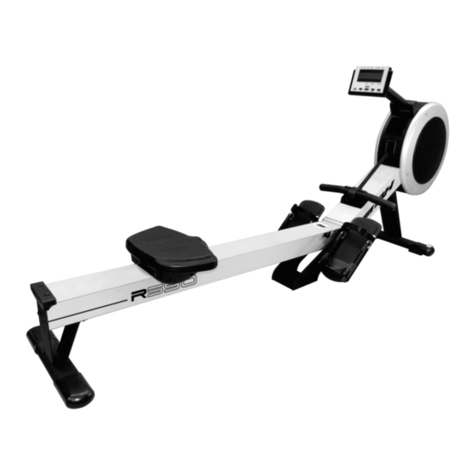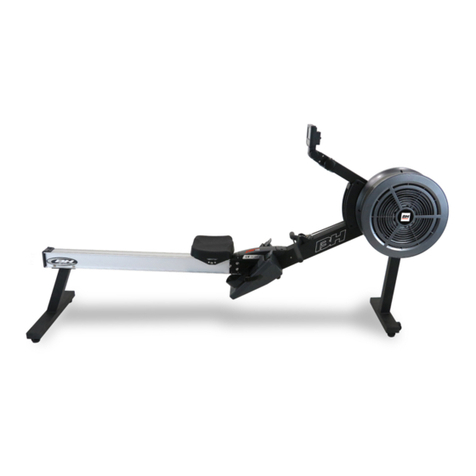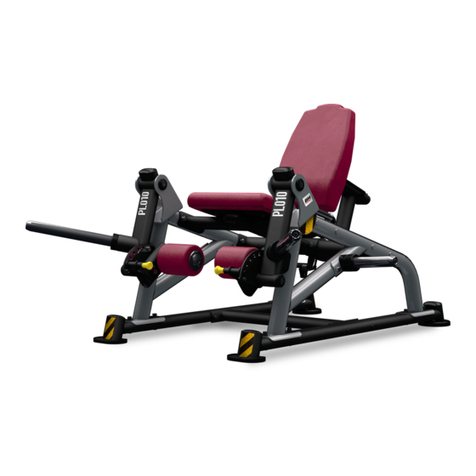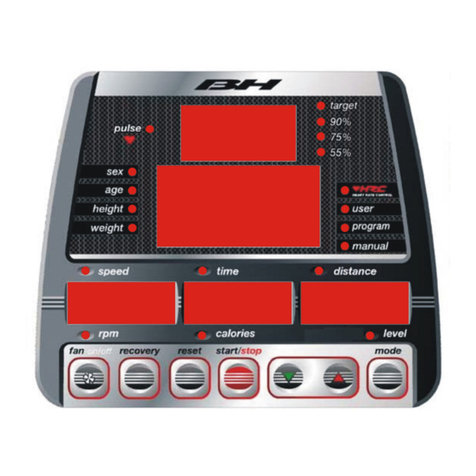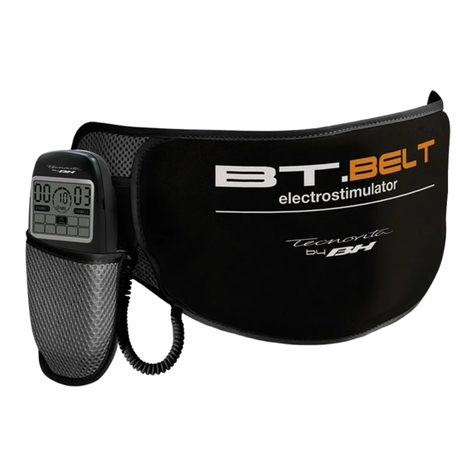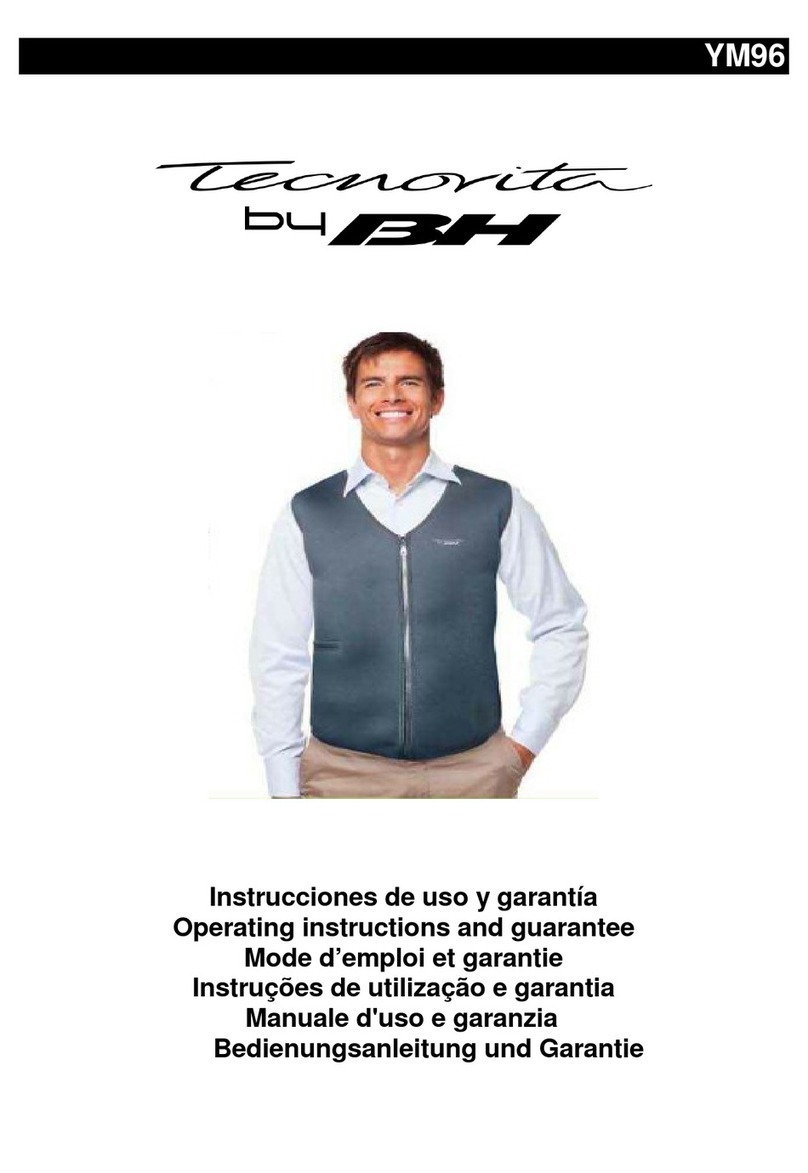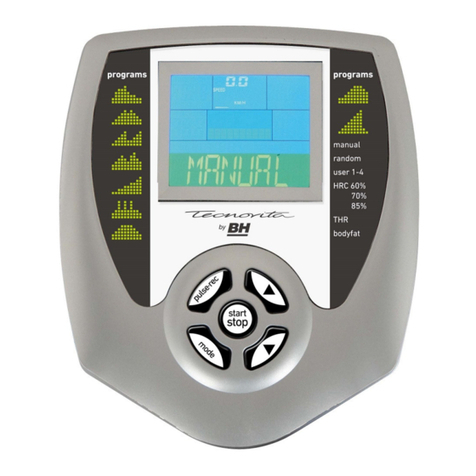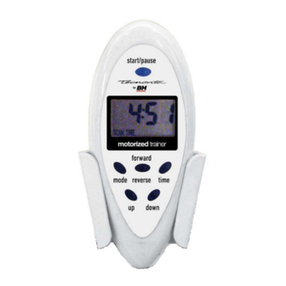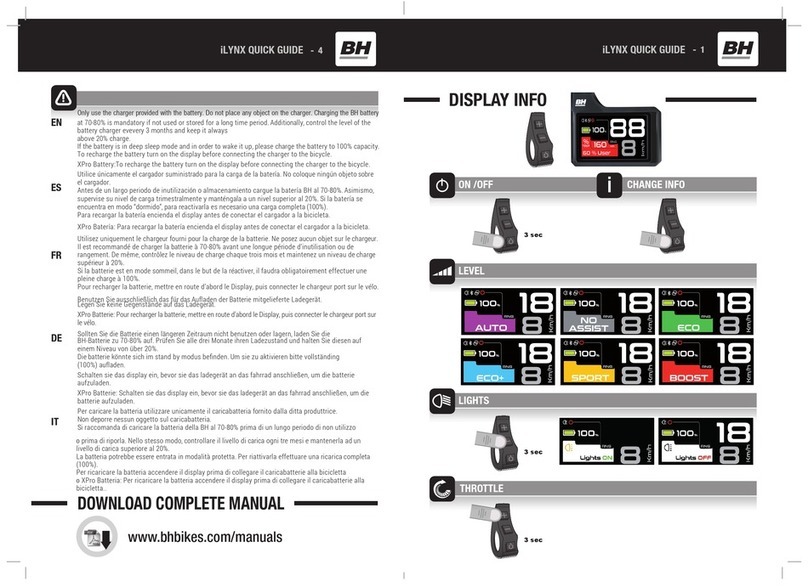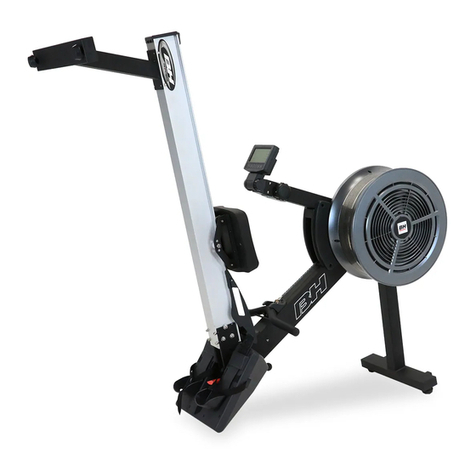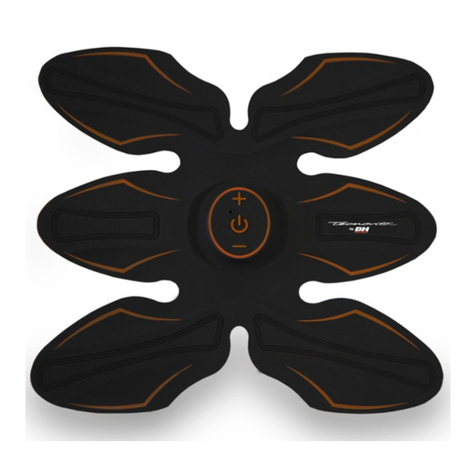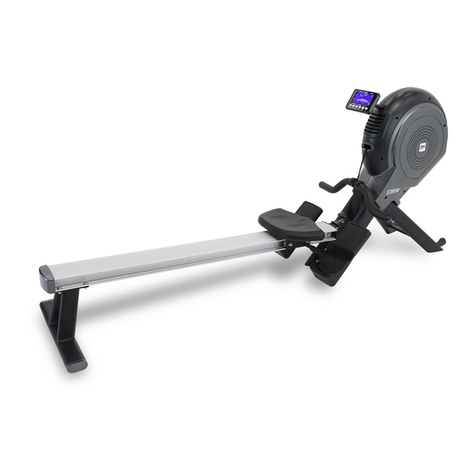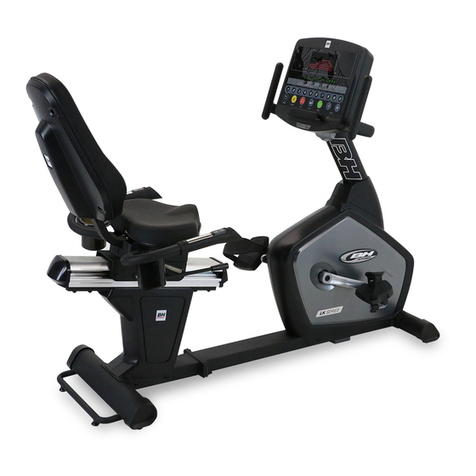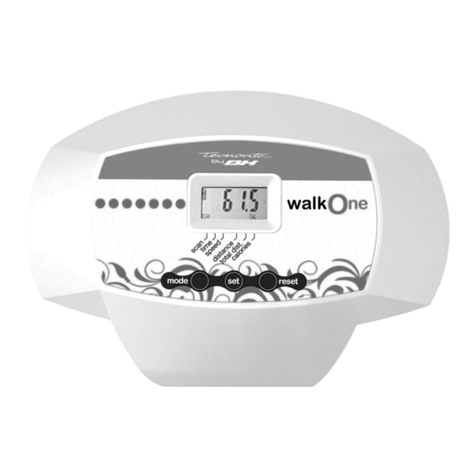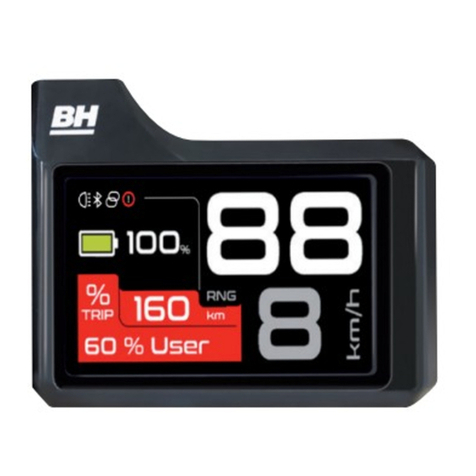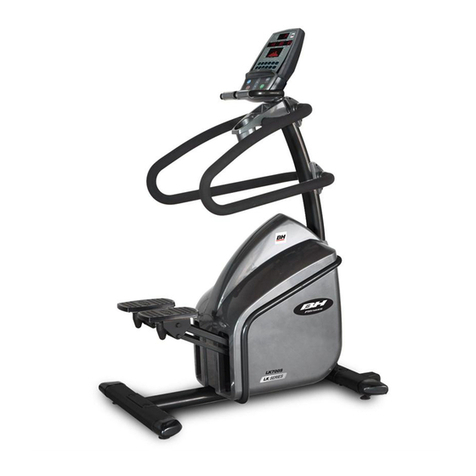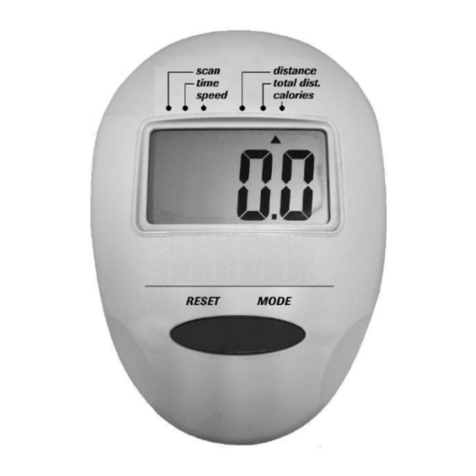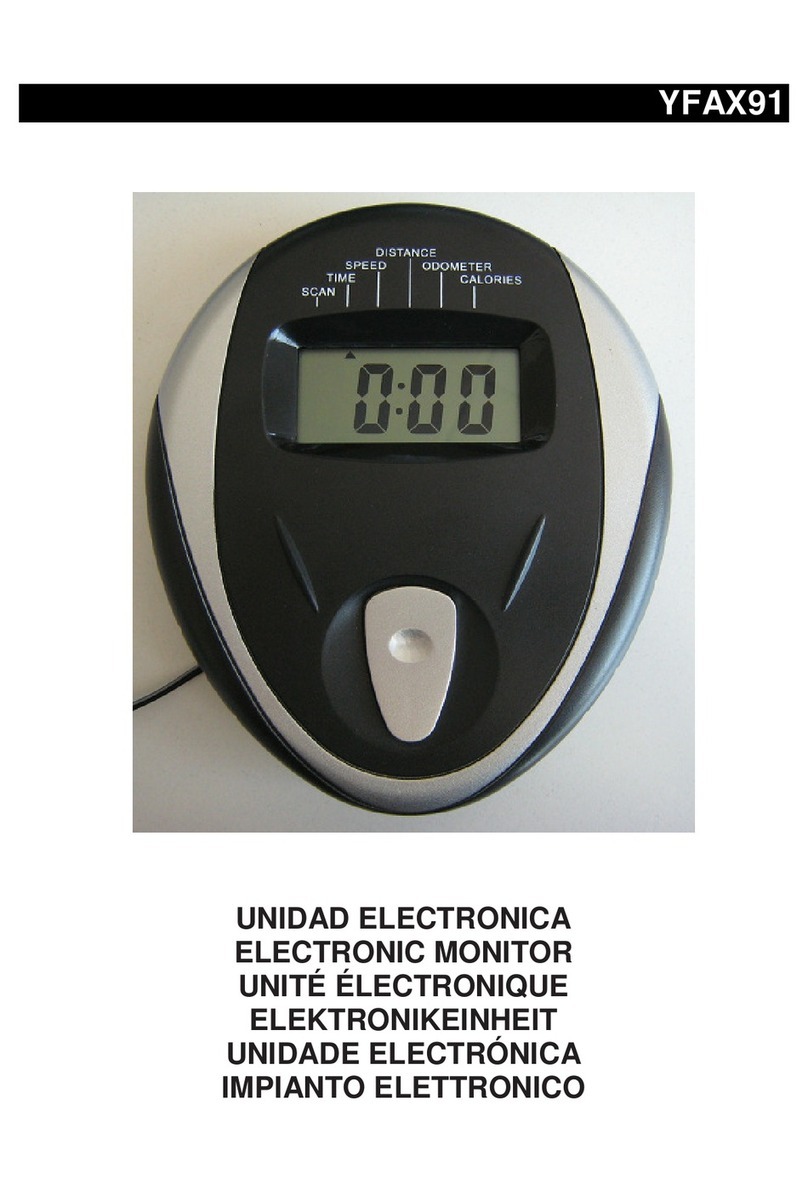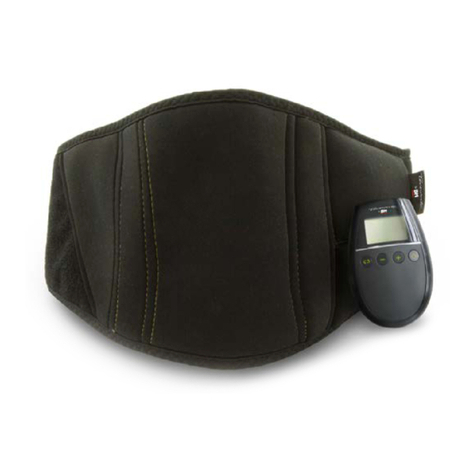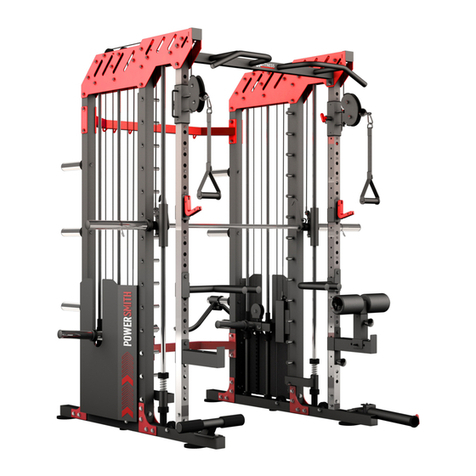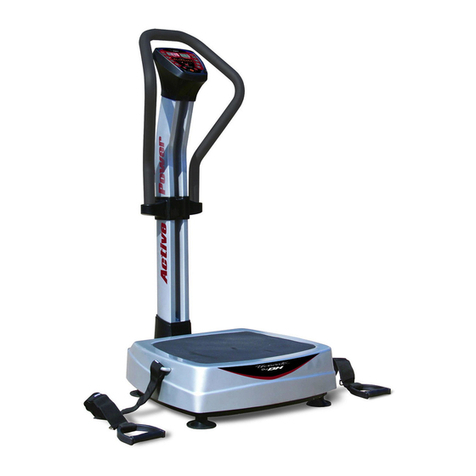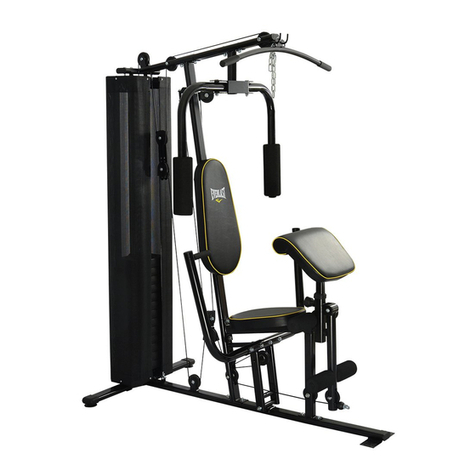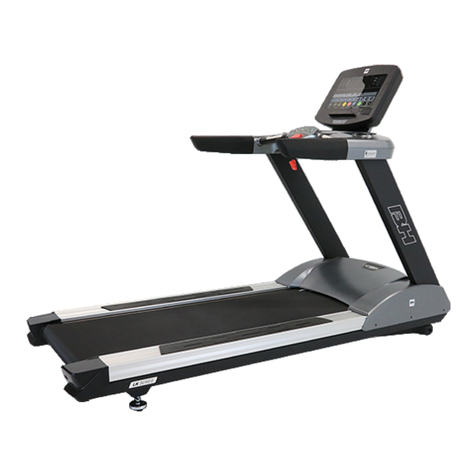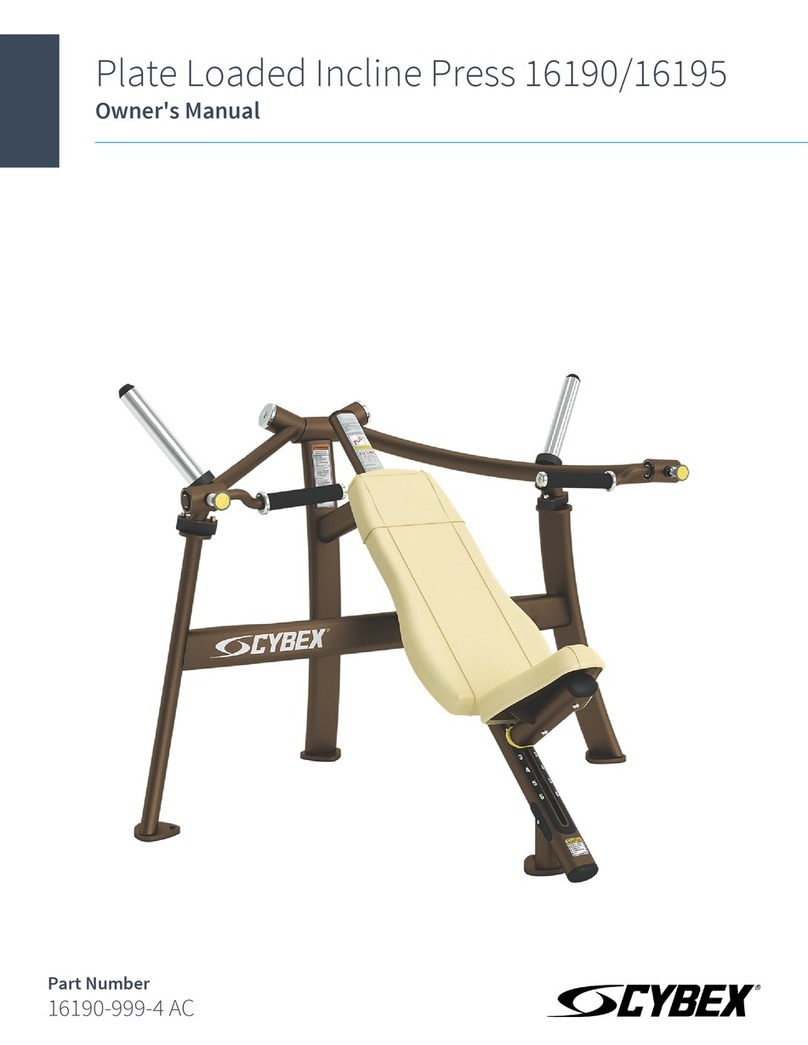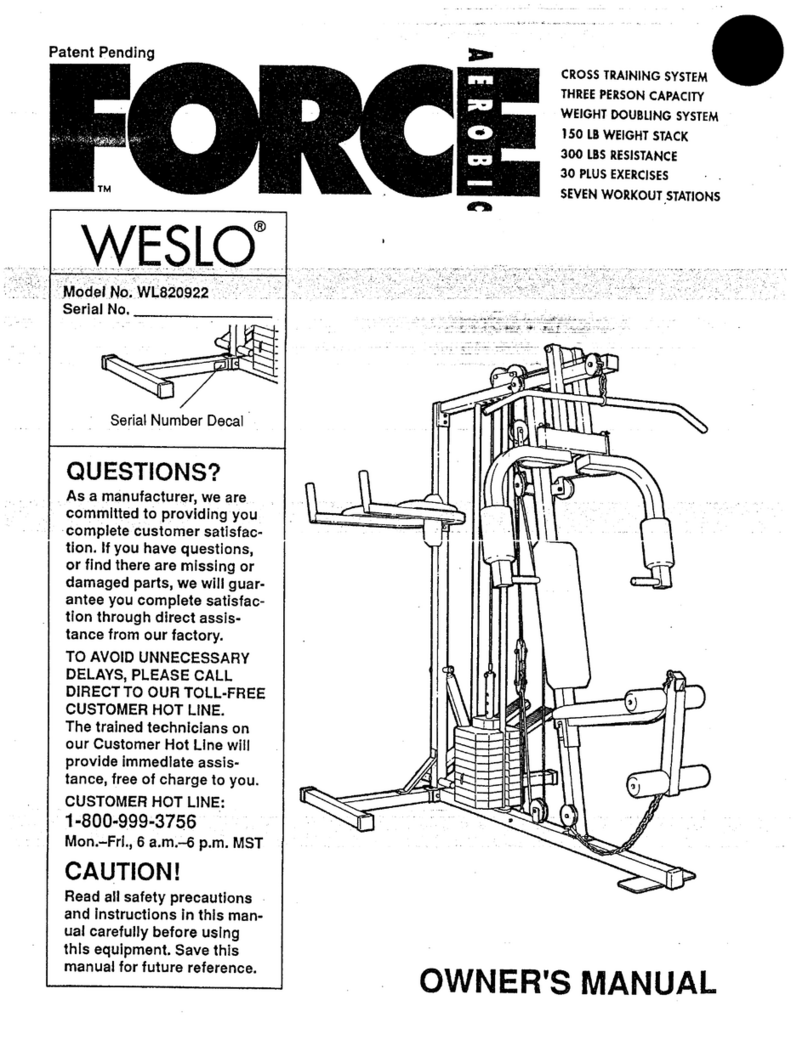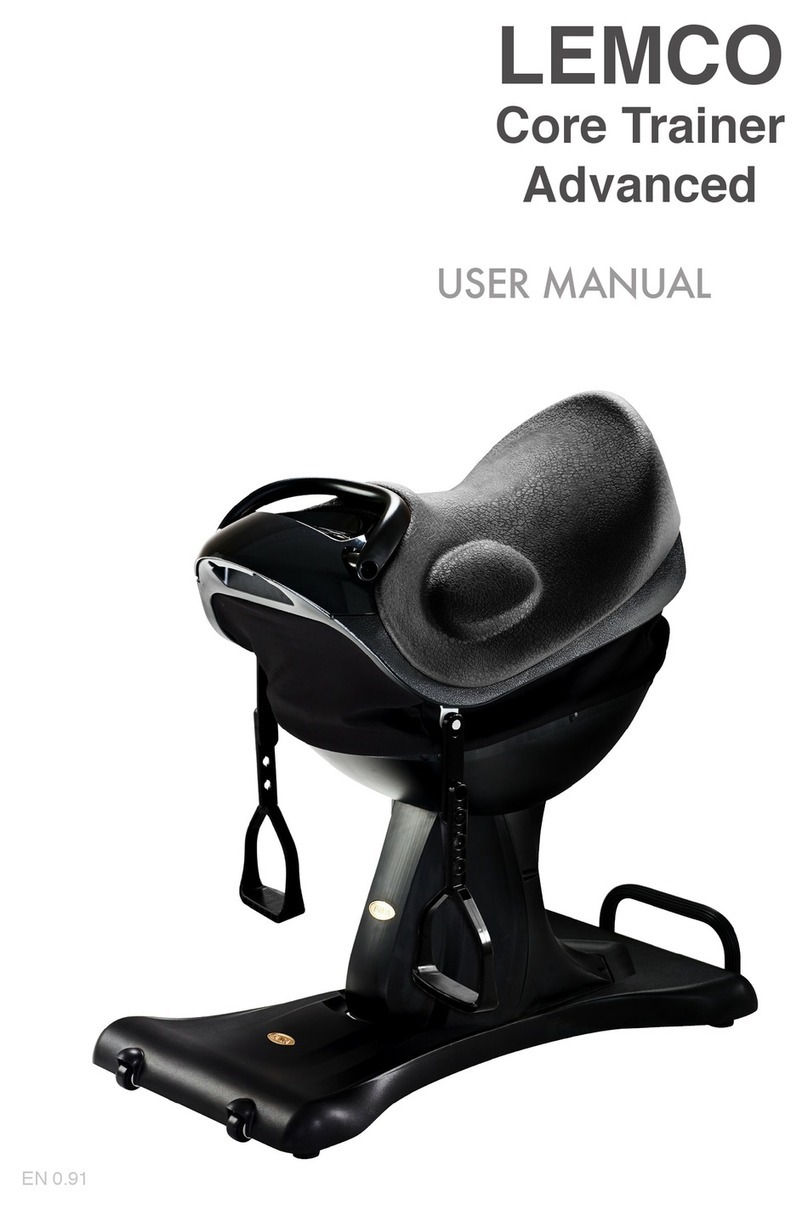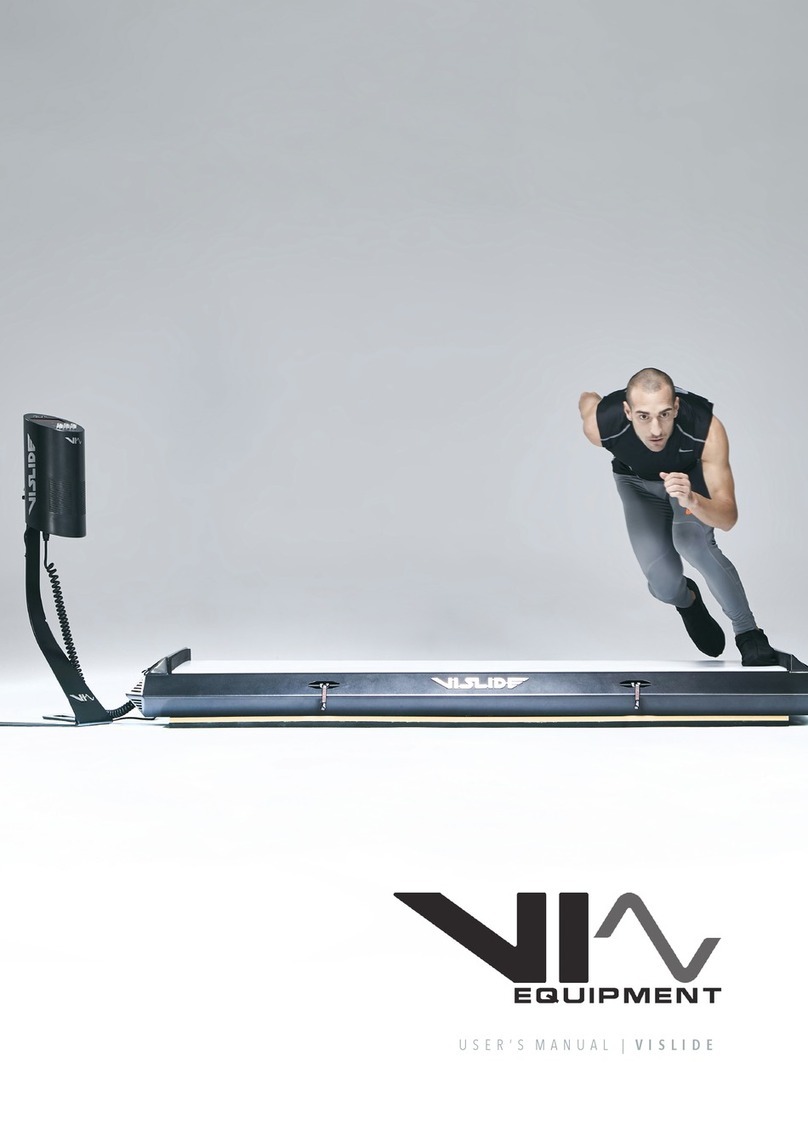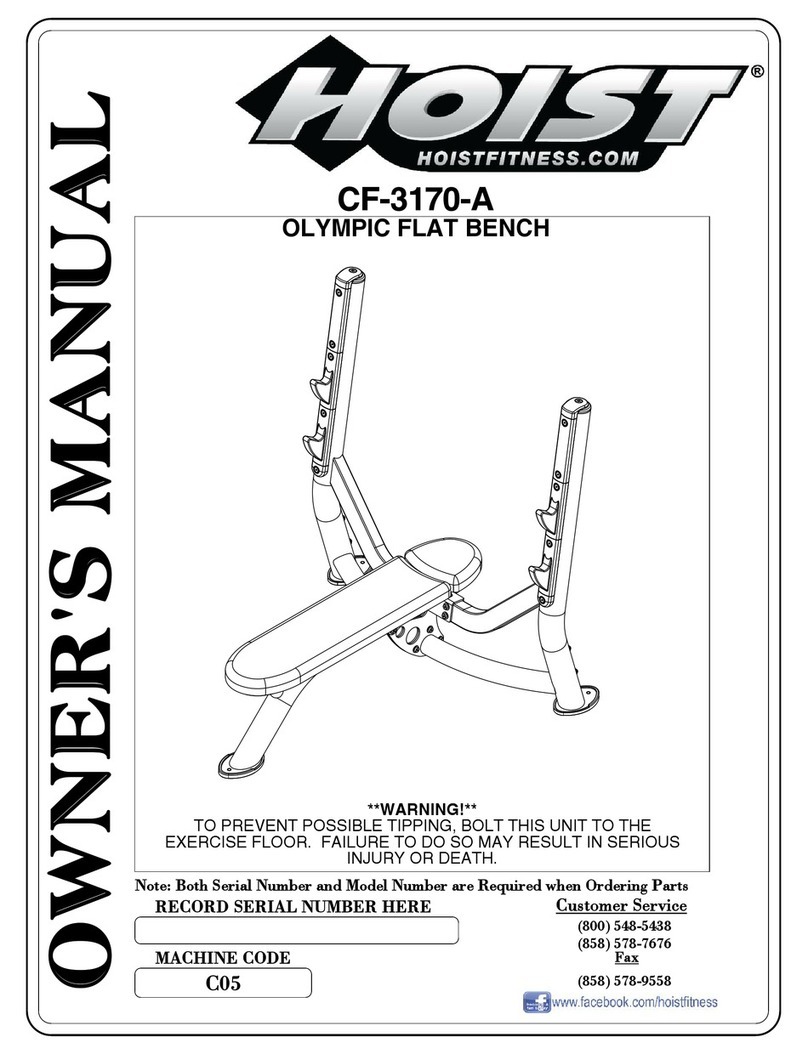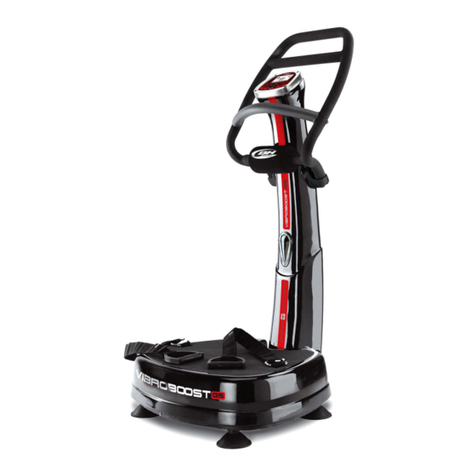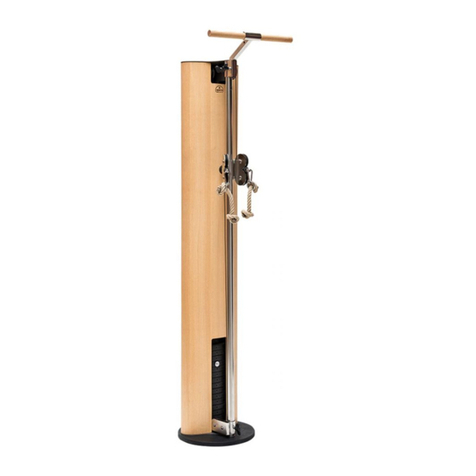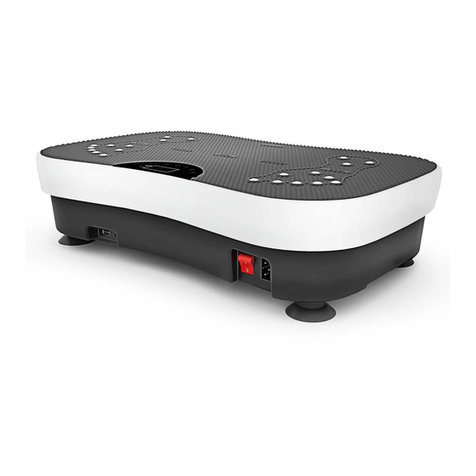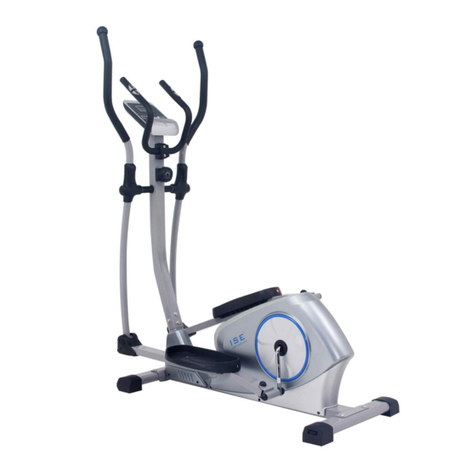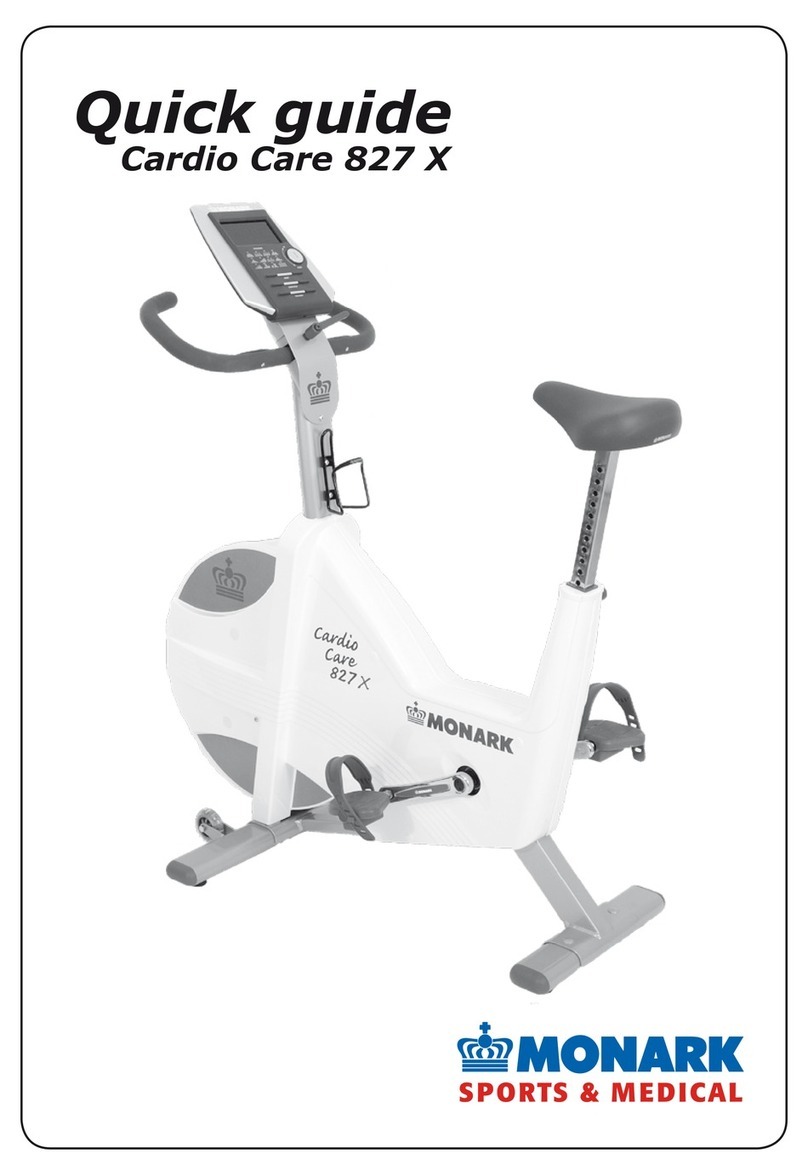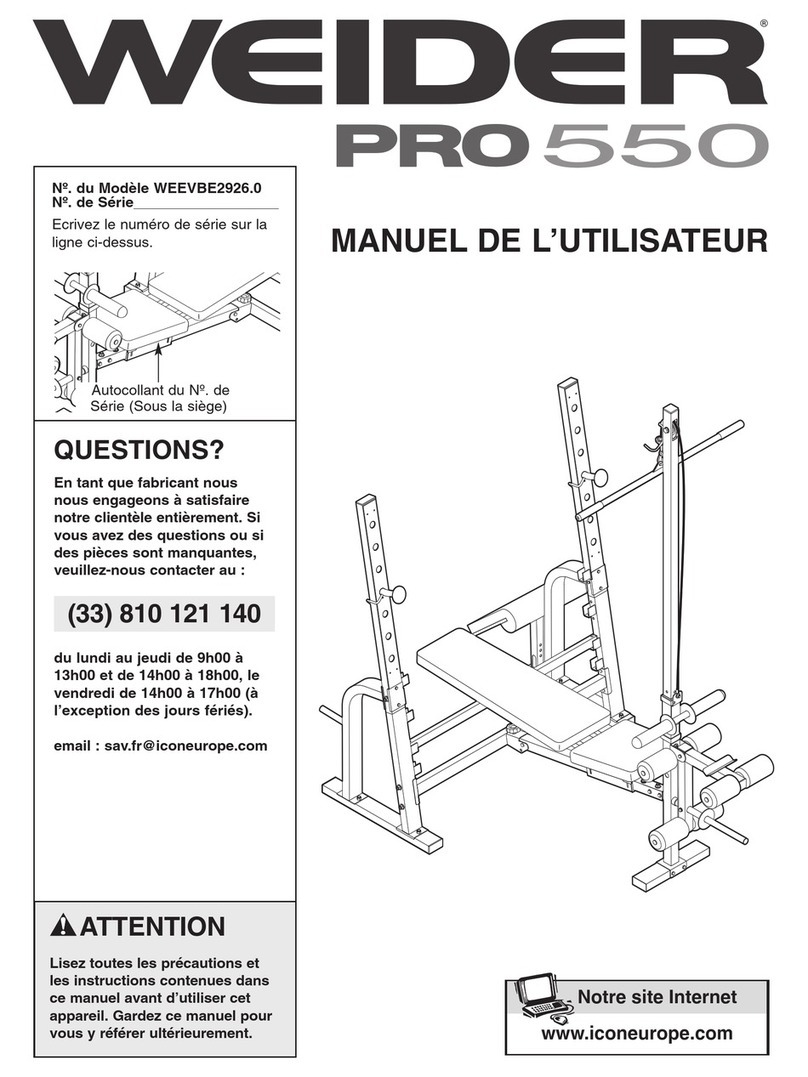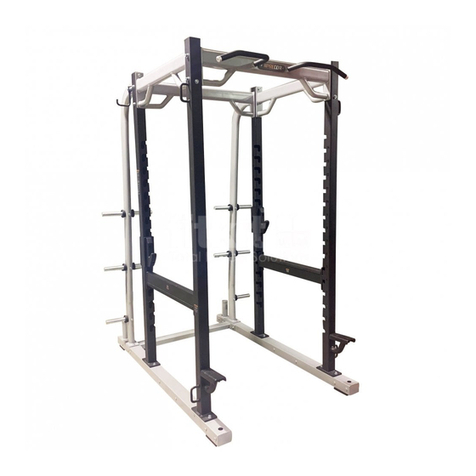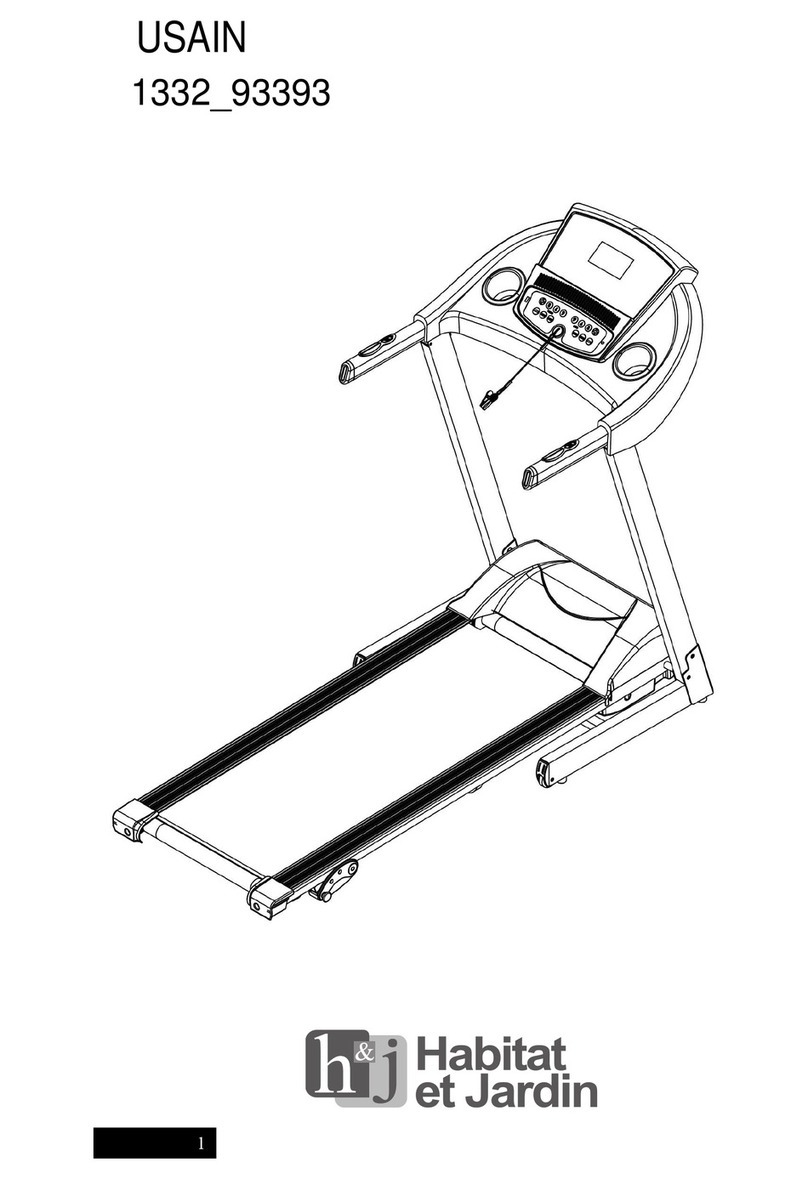BH Aquo program R309 Operator's manual

R309
Instrucciones de montaje y utilización
Instructions for assembly and use

2
Fig.0

3
Fig.1
Fig.2

4
Fig.3
Fig.4

5
Fig.5
Fig.6

6
Fig.7

7
Español
INSTRUCCIONES DE SEGURIDAD.-
Este aparato ha sido diseñado y
construido de modo que proporcione
la máxima seguridad. Sin embargo,
deben aplicarse ciertas precauciones
al utilizar aparatos de ejercicio. Lea el
manual en su totalidad antes de
montar y utilizar la máquina.
Guarde estas instrucciones.
USO
1.-Esta unidad está diseñada para uso
doméstico. No es apropiado para uso
profesional o clínico.
2.- El peso de usuario no debe
exceder de 120 Kg.
3.- Esta unidad dispone de un sistema
de rotación dependiente de la
velocidad con un freno magnético.
4.- Este aparato ha sido probado y
cumple los requisitos de los estándares
europeos EN ISO 20957-1 y EN957-7
bajo la clase H.C.
5.- Los padres y otras personas
responsables de los niños deben de
tener en cuenta la naturaleza curiosa
de estos y que puede llevarles a
situaciones y conductas que pueden
resultar peligrosas. Esta unidad no ha
de utilizarse en ningún caso como
juguete. No los deje desatendidos en
la habitación en la que guarda el
aparato.
Las personas discapacitadas no
deberán utilizar la máquina sin la
asistencia de una persona cualificada
o un médico.
RIESGO PARA LA SALUD
Precaución: Antes de comenzar a
utilizar el remo, consulte a su
médico.
Esta advertencia es especialmente
importante para personas de edades
superiores a 35 años o con
problemas de salud.
1.- Los sistemas de monitorización de
pulso pueden ser poco precisos.
Si sufre mareos, náuseas, dolor en el
pecho o cualquier otro síntoma
durante la utilización de este aparato,
PARE el ejercicio. ACUDA A UN
MÉDICO INMEDIATAMENTE.
2.- Trabaje en el nivel de ejercicio
recomendado, no llegue al
agotamiento. El uso incorrecto o el
exceso de ejercicio repercute
negativamente en su salud.
3.- Antes de utilizar este aparato,
realice un calentamiento con
ejercicios de estiramiento.
INDICACIONES GENERALES
1.- Retire todas las partes del cartón
de embalaje e identifíquelas con
respecto al listado, para asegurarse
de que no falta ninguna. No elimine el
cartón hasta haber montado el remo
completamente.
2.- Utilice el aparato siempre de
acuerdo con las instrucciones. Si
encuentra algún componente
defectuoso durante el montaje o
comprobación del aparato, o si oye
algún ruido extraño durante la
utilización, pare y contacte con el
servicio de asistencia técnica oficial.
No utilice este aparato hasta que se
haya solucionado el problema.

8
3.- Compruebe el remo antes de
comenzar el ejercicio, para
asegurarse de que se han montado
todas las piezas y que las tuercas,
tornillos, pedales y brazos se han
apretado correctamente antes del uso.
4.- Utilice sólo componentes originales
del fabricante. El uso de otros
componentes o modificaciones en la
máquina invalida la garantía.
5.- Utilice el aparato sobre una
superficie sólida y a nivel. NO utilice el
remo cerca del agua o al aire libre.
6.- Por razones de seguridad, el
equipo deberá disponer a su
alrededor de un espacio libre no
inferior a 1 m. No coloque objetos
cortantes alrededor de la máquina.
7 Utilice este aparato sólo para los
fines descritos en este manual. NO
utilice accesorios no recomendados
por el fabricante.
8.- Mantenga las manos alejadas de
las partes en movimiento.
9.-Utilice una indumentaria adecuada
para la realización de ejercicio. No
use prendas holgadas que podrían
engancharse en el remo. Utilice
siempre calzado para correr o para
aerobic cuando utilice la máquina.
Átese los cordones correctamente.
10.- Es responsabilidad del propietario
asegurarse que todos los usuarios de
la máquina estén adecuados e
informados sobre todas las
precauciones necesarias. Su unidad
sólo puede ser usada por una persona
al mismo tiempo.
11.- Revise periódicamente el apriete
de los tornillos y reapriételos si es
necesario. Compruebe ruidos
extraños y contacte con el servicio de
asistencia técnica oficial si tiene
dudas.
INSTRUCCIONES PARA EL
EJERCICIO.-
El uso del remo le reportará diferentes
beneficios, mejorará su condición
física, tono muscular y, junto con una
dieta baja en calorías, le ayudará a
perder peso.
1 La fase de calentamiento.
Esta fase acelera la circulación
sanguínea en el cuerpo y pone a tono
los músculos para el ejercicio.
También reduce el riesgo de
calambres y lesiones musculares. Es
aconsejable realizar algunos ejercicios
de estiramiento, según se muestra
más adelante.
Realice cada estiramiento
aproximadamente durante 30
segundos, no fuerce los músculos. Si
siente dolor, PARE.
2. La fase de ejercicio.
En esta fase se realiza el esfuerzo
más importante. Tras el ejercicio
regular, los músculos de los brazos
aumentarán su flexibilidad.
Es muy importante mantener un ritmo
constante. El ritmo de ejercicio será lo
bastante alto para aumentar las
pulsaciones hasta la zona objetivo
que se muestra en el gráfico
siguiente.

9
Esta fase debería durar un mínimo de
12 minutos aunque se recomienda a
la mayoría de la gente comenzar con
períodos de 10-15 minutos.
3. La fase de relajación
Esta fase permite la relajación del
sistema cardiovascular y muscular. Se
trata de una repetición de los
ejercicios de calentamiento, por
ejemplo, reduciendo el ritmo, y
continuando aproximadamente 5
minutos. Repita los ejercicios de
estiramiento, y recuerde no forzar los
músculos.
Según transcurran los días, necesitará
entrenamiento más prolongados y de
mayor intensidad. Es recomendable
ejercitarse un mínimo de tres días por
semana, en días alternos.
Tonificación muscular.
Para tonificar los músculos durante el
ejercicio deberá seleccionar una
resistencia alta. Esto implicará una
mayor tensión sobre la musculatura
de los brazos y quizás deba reducir el
tiempo del ejercicio. Si también desea
mejorar su forma física general,
deberá cambiar su programa de
entrenamiento. Realice los ejercicios
de calentamiento y relajación de
costumbre, pero cuando esté llegando
al final de la fase de ejercicio,
aumente la resistencia para someter
sus brazos a un mayor esfuerzo.
Deberá reducir la velocidad para
mantener el ritmo cardíaco en la zona
objetivo.
1.- INSTRUCCIONES DE
MONTAJE.-
Saque la unidad de la caja y
compruebe que tiene todas las piezas
Fig.0.
Se recomienda la ayuda de una
segunda persona para la
realización de este montaje.
(1) Cuerpo principal.
(2) Carril de asiento.
(3) Soporte trasero de carril.
(4) Tubo caballete delantero con
ruedas.
(5) Soporte de apoya pies.
(16L) Apoya pies Izquierdo.
(16R)Apoya pies Derecho.
(27) Asiento.
(32) Monitor electrónico.
(21) Tapa carril izquierda (L).
(22) Tapa carril derecha (R).
Tornilleria.-
(26) Tapón embellecedor.
(33) Tornillo cabeza alomada DIN603
M-10x75.
(34) Arandela curvada M-10x25x1,5.
(35) Tuerca ciega de M-10.
(36) Tornillo cabeza alomada DIN603
M-10x50.
(37) Arandela plana M-10.
(38) Tornillo allen M-8x15.
(39) Arandela plana M-8.
(40) Tornillo allen M-8x22.
(46) Arandela plana M-6.
(47) Tornillo allen M-6x15.
(48) Eje de giro apoya pies.
Llave de allen de 4mm.
Llave de tubo mixta con destornillador
estrella.
Llave combinada

10
2.- COLOCACIÓN DE TUBO
CABALLETE.-
Acerque el tubo de caballete delantero
con ruedas (4) al cuerpo central (1),
Fig.1, introduzca los tornillos (33),
coloque las arandelas curvadas (34),
y las tuercas ciegas (35) y
ayudándose de la llave de allen de
6mm.apriete fuertemente.
3.- MONTAJE DE LOS APOYA
PIES.-
En primer lugar posicione el apoya pies
izquierdo (16L) eN la “U” del soporte (5)
Fig.1A. Introduzca el eje (48) por el
agujero del apoya pies y coloque por
cada extremo el tornillo (47) junto con la
arandela (46) y ayudándose de la llave
de allen de 4mm, apriete fuertemente.
Realice similar montaje con el apoya
pies redicho (16R) descrito en el párrafo
anterior Fig.1A.
Acerque el soporte de apoya pies (5) al
cuerpo principal (1) Fig.1.
Introduzca los tornillos (36), coloque las
arandelas curvadas (37), y las tuercas
ciegas (35) y ayudándose de la llave de
allen de 6mm, apriete fuertemente.
4.- MONTAJE DEL CARRIL DE
ALUMINIO.-
Introduzca el carril de aluminio (2) en
dirección de la flecha, en el cuerpo
central (1) Fig.2.
Coloque los tornillos (38) junto con las
arandelas (39) Fig.2 y ayudándose de
la llave de allen de 6mm, apriete
fuertemente.
5.- MONTAJE SILLÍN.-
Realizado el montaje del carril de
aluminio, introduzca el sillín (27) en el
carril (2), en dirección de la flecha como
le muestra la Fig.2.
Coloque los topes de recorrido del sillín
montando los tornillos (40) junto con el
tapones embellecedores (26) y
ayudándose de la llave de allen de
6mm, apriete fuertemente.
Coloque las tapas embellecedoras
(21) y (22) en el extremo del carril de
aluminio como le muestra la Fig.2.
6.- MONTAJE DEL SOPORTE
TRASERO.-
Posicione el soporte trasero (3) en la
parte inferior del carril (2), Fig.3.
Coloque los tornillos (38) junto con las
arandelas (39) y ayudándose de la
llave de allen de 6mm, apriete
fuertemente.
7.- MONTAJE DEL MONITOR
ELECTRÓNICO.-
Retire la banda aislante situada en la
parte trasera del monitor (32) para
que las pilas hagan contacto y
compruebe que el monitor se
enciende.
Posicione el monitor electrónico (32)
junto al alojamiento del cuerpo
principal (1) Fig.5.
Conexiones los terminales del monitor
(32), con los terminales que salen del
cuerpo principal (1) Fig.5A, e
introduzca el monitor en el alojamiento
del cuerpo principal (1) Fig.5, teniendo
cuidado con los cables.
NIVELACIÓN.
Una vez colocada la unidad en su
lugar definitivo, para la realización del
ejercicio, compruebe que el
asentamiento en el suelo y su
nivelación sean correctos. Esto se
conseguirá girando más o menos los
tacos de apoyo (24) como muestra la
Fig.6.

11
MOVIMIENTO Y ALMACENADO.-
La unidad está equipada con ruedas
(14) lo que hace más sencillo su
movimiento.
Las ruedas que se encuentran en la
parte delantera de su unidad, le
facilitarán la maniobra de colocar su
unidad en el emplazamiento escogido,
levantando, ligeramente por la parte
delantera y empujando, como muestra
la Fig.4.
Guarde su máquina en un lugar seco
con las menores variaciones de
temperatura posible.
CONEXIÓN A LA RED.-
Introduzca la clavija (m) de enganche
del transformador en el punto de
conexión (k), del cuerpo central, (parte
trasera inferior) Fig.6 y conecte el
transformador (6) de corriente a la red
de 230V. Fig.6.
Para cualquier consulta, no dude en
ponerse en contacto con el
(S.A.T).Servicio de Asistencia
Técnica, llamando al teléfono de
atención al cliente (ver página final del
presente manual).
BH SE RESERVA EL DERECHO A
MODIFICAR LAS ESPECIFICACIO-
NES DE SUS PRODUCTOS SIN
PREVIO AVISO.

12
English
SAFETY INSTRUCTIONS.-
This rower has been designed and
constructed to provide maximum
safety. Nevertheless, certain
precautions should be taken when
using exercise equipment. Carefully
read through the instructions
contained in this manual. It provides
you with important information about
assembly, safety and use of the
machine.
Keep these instructions safe for
future use.
USE
1. This unit has been designed for
home use. It is not suitable for
commercial or therapeutic use.
2. The user weight does not have to
exceed 120kg
3. This unit has a rotation speed
dependent system with a magnetic
braking system.
4. This appliance has been tested and
it complies with standard EN ISO
20957-1 and EN957-7 under class
H.C.
5. Parents and/or those responsible
for children should always take their
curious nature into account and how
this can often lead to hazardous
situations and behaviour resulting in
accidents. This unit does not have to
be used in any case like toy. DO NOT
leave them unsupervised in the room
where this machine is kept.
Disabled people should not use the
machine without the assistance of a
qualified person or a doctor.
HEALTH HAZARDS
Caution: Consult your doctor
before beginning to use the rower.
This advice is especially important
for those over 35 or suffering from
health problems.
1. Heart rate monitoring systems can be
inaccurate.
If you experience dizziness, nausea,
chest pains or any other symptom
while using this appliance STOP the
exercise. SEEK MEDICAL
ATTENTION IMMEDIATELY.
2. Work at the recommended exercise
level, do not overexert yourself.
Incorrect or excessive exercising can
endanger your health.
3. Do warm up stretching exercises
before using the equipment
GENERAL INSTRUCTIONS
1. Remove all the parts from the
cardboard packaging and check them
against the parts list to ensure that there
is nothing missing. Do not throw the
cardboard away until the rower trainer is
fully assembled.
2. Always use the appliance in
accordance with the instructions. If you
discover any defective component while
assembling or checking the equipment,
or if you hear any strange noise during
exercise then stop and contact
customer care service. Do not use the
appliance until the problem has been
solved.
3. Check the rower trainer before
starting the exercise; to make sure that
all of the parts are attached and that the
nuts, bolts, pedals and focus bars have
been tightened correctly prior to use.

13
4. Use original spares from supplier.
The replacement or modification of
any component, other than what is
approved by supplier, will void your of
warranty.
5. Use the appliance on a level, solid
surface. DO NOT use the rower
outdoors or close to water.
6. In the interest of safety, the
equipment must have at least 1 metre of
free space around it. Do not place
sharp objects near the machine.
7 This appliance must only be used for
the purposes described in this manual.
DO NOT use accessories that are not
recommended by the manufacturer.
8 Keep your hands well away from
any of the moving parts.
9 Wear clothing suitable for doing
exercise. Do not use baggy clothing
that might get caught up in the bicycle.
Always wear running shoes or trainers
when using the machine. Make sure
all laces/cords are tied correctly.
10 The owner is responsible for
ensuring that anyone who uses the
machine is duly informed about the
necessary precautions.
11. Check at regular intervals whether
all screw connections are tight, and
retighten them as required. Check
regularly for damage and wear and
contact customer care if any doubt.
EXERCISE INSTRUCTIONS.-
Use of the ROWER TRAINER offers
various benefits; it will improve fitness,
muscle tone and when used in
conjunction with a calorie controlled diet
it will help you to lose weight.
1,Warm-up phase
This phase speeds up the body’s blood
circulation and gets the muscles ready
for exercise. It also reduces the risk of
cramp and sprains. It is advisable to do
some stretching exercises, as shown
below. Each stretch should last
approximately 30 seconds, do not
overexert the muscles. If you feel pain,
STOP.
2. Exercise phase
This phase requires the greatest
physical exertion. After regular
exercise the arm muscles will become
more flexible. It is important to keep
the rhythm constant. The rhythm of
the exercise should be fast enough to
bring the heart rate into the target
area, as shown on the following graph:
This phase should last at least 12
minutes, although it is advisable for
most people to start off with sessions
of 10-15 minutes.
3. Cool-down phase
This phase allows the cardiovascular
and muscle system to relax. It consists
of repeating the warm-up exercises,
i.e. reducing the rhythm and
continuing for approximately 5
minutes. Repeat the stretching
exercises but remember not to
overexert the muscles.

14
Eventually your training sessions will
have to become longer and more
intensive. It is advisable to exercise at
least three days per week, on
alternate days.
Muscle toning
You should select a high exertion level
in order to tone muscles during
exercise. This entails greater stress on
the arm muscles, so it may be wise to
reduce exercise times. If you also wish
to improve your overall fitness then
you should change your training
program. Do the warm-up and cool-
down exercises as normal but when
you are reaching the end of the
exercise phase, increase the exertion
level in order to make your arms work
harder. You should reduce speed in
order to keep your heart rate within
the target area.
1.- ASSEMBLY INSTRUCTIONS.-
Take the unit out of its box and make
sure that all of the pieces are there
Fig.0:
The assistance of a second person
is recommended when assembling
this unit.
(1) Main body.
(2) Seat rail.
(3) Rear rail support.
(4) Front stabiliser bar with wheels.
(5) Foot rest support.
(16L) Left footrest.
(16R)Right footrest.
(27) Seat.
(32) Electronic monitor;
(21) Left rail cover (L).
(22) Right rail cover (R).
Nuts & Bolts.
(26) Screw cap
(33) Coach bolt DIN603 M-10x75.
(34) Curved washer M-10x25x1.5.
(35) Cap nut M-10.
(36) Coach bolt DIN603 M-10x50.
(37) Flat washer M-10.
(38) Allen screw M-8x15.
(39) Flat washer M-8.
(40) Allen screw M-8x22.
(46) Flat washer M-6.
(47) Allen screw M-6x15.
(48) Footrest rotation shaft.
Allen key 4mm
Box spanner with star screw-driver
Combination spanner.
2.- FITTING THE STABILISER
BARS.-
Bring the front stabiliser bar with
wheels (4) to the main body (1) Fig.1,
insert bolts (33), fit the curved
washers (34) the cap nuts (35). Use
the 6mm Allen key to tighten securely.
3.- MOUNTING THE FOOT
RESTS.-
Firstly, position the left foot rest (16L)
in the “U” of the support (5) Fig.1A.
Insert pin (48) through the foot rest
hole and insert screw (47) in each
end, in addition to washer (46) y and
then firmly tighten with the 4mm Allen
wrench.
Repeat the operation described above
for the right foot rest (16R), as shown
in Fig.1A.
Move the foot rest support (5) towards
the main frame (1) Fig.1.
Insert screws (36), mount the curved
washers (37), and cap nuts (35) and
then firmly tighten with the 6 mm Allen
wrench.

15
4.- MOUNTING THE ALUMINIUM
RAIL.-
Insert aluminium rail (2) in the
direction indicated by the arrow, into
the central frame (1) Fig.2.
Insert screws (38) with washers (39)
Fig.2 and then firmly tighten with the 6
mm Allen wrench.
5.- MOUNTING THE SEAT.-
Once the aluminium rail has been
assembled, insert seat (27) in rail (2),
in the direction indicated by the arrow,
as shown in figure Fig.2.
Insert the seat travel stops by
mounting screws (40) together with
the end caps (26) and then firmly
tighten with the 6mm Allen wrench.
Mount end caps (21) and (22) at the
end of the aluminium rail as shown in
Fig.2.
6.- MOUNTING THE REAR
SUPPORT.-
Position rear support (3) on the bottom
of rail (2), Fig.3.
Insert screws (38)
and washers (39) and then firmly
tighten with the 6mm Allen
wrench.
7.- MOUNTING THE
ELECTRONIC CONSOLE.-
Remove the insulating strip located on
the back of the monitor (32) for
batteries make contact and make sure
the monitor is turned on.
Position the electronic console (32)
next to the seat in the main frame (1)
Fig.5.
Connect the console terminals (32),
with the terminals running from the
main frame (1) Fig.5A, and insert the
console in the seat in the main frame
(1) Fig.5, taking care with the cables.
LEVELLING.-
Once the unit has been placed into its
final position for doing exercise, make
sure that it sits flat on the floor and
that it is level. This can be achieved by
screwing the adjustable support
blocks (24) up or down, as shown in
Fig.6.
MOVEMENT & STORAGE.-
The unit is equipped with wheels (14)
to make it easier to move. The wheels
located at the front of your unit make it
easier to move it into a chosen
position, by lifting the rear of the unit
up slightly and pushing it, as shown in
Fig.4. Store your unit in a dry place,
preferably not subject to changes in
temperature.
MAINS CONNECTION.-
Insert the jack (m) for the transformer
into the connection hole on the main
body (k) (bottom, rear of the machine)
and then plug the transformer (6) into
a 230 V mains supply, Fig.6.
Do not hesitate to get touch with the
Technical Assistance Service if you
have any queries by phoning customer
services (see last page in manual)
BH RESERVES THE RIGHT TO
MODIFY THE SPECIFICATIONS OF
ITS PRODUCTS WITHOUT PRIOR
NOTICE

16
ESPAÑOL
TECNICA DEL REMO
1.- ATAQUE
- Brazos parcialmente estirados.
- Piernas recogidas contra el cuerpo.
- Cuerpo ligeramente hacia delante.
2. COMIENZO DE LA ACCION
- Brazos estirados.
- Comenzar el movimiento de las
piernas.
- Remo por encima de las rodillas.
- El cuerpo se mueve en posición
vertical.
3. ACCION
- Piernas continúan empujando.
- Brazos se doblan una vez pasada la
altura de las rodillas.
4.- FINAL
- El tirador del remo se coloca a la
altura del pecho.
- Piernas parcialmente estiradas.
- Cuerpo ligeramente inclinado hacia
atrás.
5.- RECUPERACION
- Brazos estirados hacia delante.
- Piernas flexionadas.
6.- PREPARACION
- Volver a la posición de ataque.
- No soltar el tirador del remo.

17
ENGLISH
ROWING TECHNIQUE
1.- ATTACK
- Arms partially stretched.
- Legs brought up against the body.
- Body leaning slightly forward.
2.- BEGIN THE ACTION
- Arms stretched fully out.
- Begin the leg movement.
- Oar above knee level.
- Body moves into the upright
position.
3.- ACTION
- Legs pushing back.
- Arms beginning to bend once they
have passed the knees.
4.- END
- The rowing bar is brought to chest
level.
- Legs partially straightened out.
- Body leaning slightly backward.
5.- RECOVERY
- Arms stretched out in front.
- Legs bent.
6.- PREPARACION
- Return to the attack position.
- Do not let go of the rowing bar.

18
R309

19
Para pedido de repuesto: Indicar el código de la pieza y la cantidad
To order replacement parts: State the part code and Quantity
Ejemplo / E.g:
R309001 1
Nº Code Nº Code Nº Code
6 R309006 19 R308019 51 R308051
7 R309007 20 R308020 58 R309058
9 R308009 21 R308021 61 R309061
10 R308010 22 R308022 68 R308068
11 R308011 23 R308023 70 R309070
12 R308012 24 R308024 76 R308076
13 R308013 26 R308026 G01 R309G01
14 R308014 27 R308027 G02 R309G02
15 R308015 29 R309029 G03 R309G03
16 R308016 30 R308030 G04 R308G04
17 R308017 32 R309032 G05 R309G05
18 R308018 43 R308043

Español Por medio de la presente Exercycle S.L. declara que este producto
cumple con los requisitos esenciales y cualesquiera otras disposiciones
aplicables o exigibles de las Directivas 2009/125/CE, 2004/108/CE y
2006/95/CE.
English Hereby, Exercycle S.L, declares that this product is in compliance with
the essential requirements and other relevant provisions of Directives
2009/125/EC, 2004/108/EC and 2006/95/EC.
Français Par la présente Exercycle S.L déclare que cette appareil est conforme
aux exigences essentielles et aux autres dispositions pertinentes des
directives 2009/125/CE, 2004/108/CE et 2006/95/CE.
Deutsch Hiermit erklärt Exercycle S.L, dass sich das Gerät in Übereinstimmung
mit den grundlegenden Anforderungen und den übrigen einschlägigen
Bestimmungen der Richtlinien 2009/125/EG, 2004/108/EG und
2006/95/EG befindet.
Português Exercycle S.L. declara que este producto está conforme com os
requisitos essenciais e outras disposições das Directivas 2009/125/CE,
2004/108/CE e 2006/95/CE.
Italiano Con la presente Exercycle S.L. dichiara che questo prodotto è conforme
ai requisiti essenziali ed alle altre disposizioni pertinenti stabilite delle
direttive 2009/125/CE, 2004/108/CE e 2006/95/CE.
Nederlands Hierbij verklaart Exercycle S.L. dat het produkt in overeenstemming is
met de essentiële eisen en de andere relevante bepalingen van
richtlijnen 2009/125/EG, 2004/108/EG en 2006/95/EG.
Table of contents
Languages:
Other BH Fitness Equipment manuals
